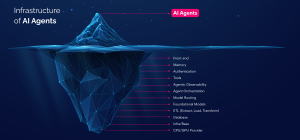In the rapidly evolving landscape of enterprise AI, the difference between good and exceptional implementation lies in the architecture beneath. Here’s the insider’s perspective on what truly powers today’s most successful AI agent deployments.
The New Reality of Enterprise AI
Imagine walking into a modern enterprise where AI agents orchestrate complex operations with apparent effortlessness—scheduling meetings across time zones, analyzing market trends in real-time, and handling thousands of customer interactions simultaneously. This visible excellence represents merely the tip of the actual system. The real innovation? It’s in the sophisticated engineering that lies beneath.
The journey to this point has been remarkable. From basic chatbots in 2023 to rudimentary AI assistants in 2024, we’ve now entered an era of truly autonomous AI agents. But this evolution isn’t just about better language models – it’s about the intricate architecture that makes enterprise-grade AI possible.
Beneath the Surfaces: Deconstructing the AI Agent Infrastructure
- The Visible Layer: Where Human Meets Machine
The sleek interfaces of platforms represent the visible face of AI agents. But this polished exterior relies on sophisticated front-end engineering. Modern implementations leverage technologies not just for aesthetics, but to create intuitive interactions that adapt to human user needs. When a sales representative requests market analysis or a developer needs code review, this layer translates complex operations into natural conversations, leading to a redefinition of our concept of User Interface/User Experience.
- The Intelligence Layer: Beyond Simple Processing
At the heart of enterprise AI lies an intricate network of complex computing systems. Memory management platforms ensure conversations maintain context across all the participants, during weeks or months. Dynamic model routing systems instantly determine whether a financial analysis requires different processing than a creative task. This orchestration happens in milliseconds, invisible to the end user but crucial for enterprise-grade performance.
- The Control Framework: Enterprise-Grade Security and Governance
In today’s regulatory environment, control systems aren’t optional – they’re critical layers. Enterprise AI agents operate within a sophisticated framework that ensures:
- Advanced MFA protects sensitive operations
- Real-time monitoring provides unprecedented operational visibility
- Advanced orchestration enables complex multi-agent workflows
- The Foundation: Scale, Speed, and Reliability
The true differentiator in enterprise AI isn’t the models – it’s the infrastructure. Cloud-native architectures powered by advanced containerization ensure global scalability. Next-generation databases enable instant information retrieval across petabytes of data. This foundation turns theoretical AI capabilities into practical business advantages.
The Engineering Reality: Why 90/10 Matters
The true value of enterprise AI agents lies not in individual AI models but in the engineering that enables their practical application. This 90% engineering, 10% LLM split reflects a crucial truth: successful AI implementation requires more robust infrastructure than cutting-edge algorithms.
Consider a global enterprise deploying an AI agent for customer support. While the LLM handles natural language understanding, the engineering infrastructure:
- Manages millions of concurrent conversations
- Ensures sub-second response times
- Maintains security compliance across jurisdictions
- Seamlessly integrates with existing business systems
- Scales resources based on demand
The Road Ahead: Next-Generation Enterprise AI
As we move forward, the architecture of enterprise AI continues to evolve. The future of enterprise AI lies not in incrementally better language models, but in more sophisticated infrastructure.
- Advanced orchestration systems enabling true multi-agent collaboration
- Predictive scaling systems that anticipate business demands
- Hybrid architectures blending cloud and edge computing
- Enhanced security frameworks for autonomous decision-making
- Sophisticated observability tools for AI governance
The Strategic Imperative
Understanding the full depth of AI agent architecture isn’t just technical knowledge – it’s a strategic advantage. Organizations that appreciate and invest in robust AI infrastructure position themselves to leverage the full potential of this transformative technology.
The visible “magic” of AI agents rests upon a foundation of sophisticated engineering. As you consider implementing AI agents in your enterprise, remember that success lies not just in choosing the right AI models, but in building and maintaining the robust infrastructure that powers them.
Ready to explore how AI agents can transform your business operations? Contact our team to discuss your AI strategy and learn how we can help build the infrastructure for your success.









 Cookie configuration
Cookie configuration